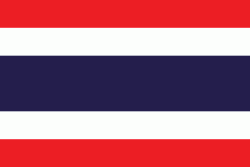Amphoe Bang Len (Bang Len)
Bang Len (บางเลน, ) is a district (amphoe) in the northern part of Nakhon Pathom province, central Thailand.
The district was created in 1896 under the name Bang Phai Nat (บางไผ่นารถ). The district office was in Ban Bang Phai Nat, Tambon Bang Sai Pa, on the east bank of the Tha Chin River. Later the government moved the central district to Tambon Bang Pla on the west bank of the Tha Chin. At the same time the district name was changed accordingly to Bang Pla. In 1939 the district was again renamed and received its current name Bang Len. The district office was moved to Tambon Bang Len in 1978.
The term Bang Len refers to 'place of mire', named after Khlong Bang Len, a tributary of Tha Chin river.
The district was created in 1896 under the name Bang Phai Nat (บางไผ่นารถ). The district office was in Ban Bang Phai Nat, Tambon Bang Sai Pa, on the east bank of the Tha Chin River. Later the government moved the central district to Tambon Bang Pla on the west bank of the Tha Chin. At the same time the district name was changed accordingly to Bang Pla. In 1939 the district was again renamed and received its current name Bang Len. The district office was moved to Tambon Bang Len in 1978.
The term Bang Len refers to 'place of mire', named after Khlong Bang Len, a tributary of Tha Chin river.
Map - Amphoe Bang Len (Bang Len)
Map
Country - Thailand
 |
 |
| Flag of Thailand | |
Tai peoples migrated from southwestern China to mainland Southeast Asia from the 11th century. Indianised kingdoms such as the Mon, Khmer Empire and Malay states ruled the region, competing with Thai states such as the Kingdoms of Ngoenyang, Sukhothai, Lan Na and Ayutthaya, which also rivalled each other. European contact began in 1511 with a Portuguese diplomatic mission to Ayutthaya, which became a regional power by the end of the 15th century. Ayutthaya reached its peak during the 18th century, until it was destroyed in the Burmese–Siamese War. Taksin quickly reunified the fragmented territory and established the short-lived Thonburi Kingdom. He was succeeded in 1782 by Buddha Yodfa Chulaloke, the first monarch of the current Chakri dynasty. Throughout the era of Western imperialism in Asia, Siam remained the only nation in the region to avoid colonization by foreign powers, although it was often forced to make territorial, trade and legal concessions in unequal treaties. The Siamese system of government was centralised and transformed into a modern unitary absolute monarchy in the reign of Chulalongkorn. In World War I, Siam sided with the Allies, a political decision made in order to amend the unequal treaties. Following a bloodless revolution in 1932, it became a constitutional monarchy and changed its official name to Thailand, becoming an ally of Japan in World War II. In the late 1950s, a military coup under Field Marshal Sarit Thanarat revived the monarchy's historically influential role in politics. Thailand became a major ally of the United States, and played an anti-communist role in the region as a member of the failed SEATO, but from 1975 sought to improve relations with Communist China and Thailand's neighbours.
Currency / Language
| ISO | Currency | Symbol | Significant figures |
|---|---|---|---|
| THB | Thai baht | ฿ | 2 |
| ISO | Language |
|---|---|
| EN | English language |
| TH | Thai language |















